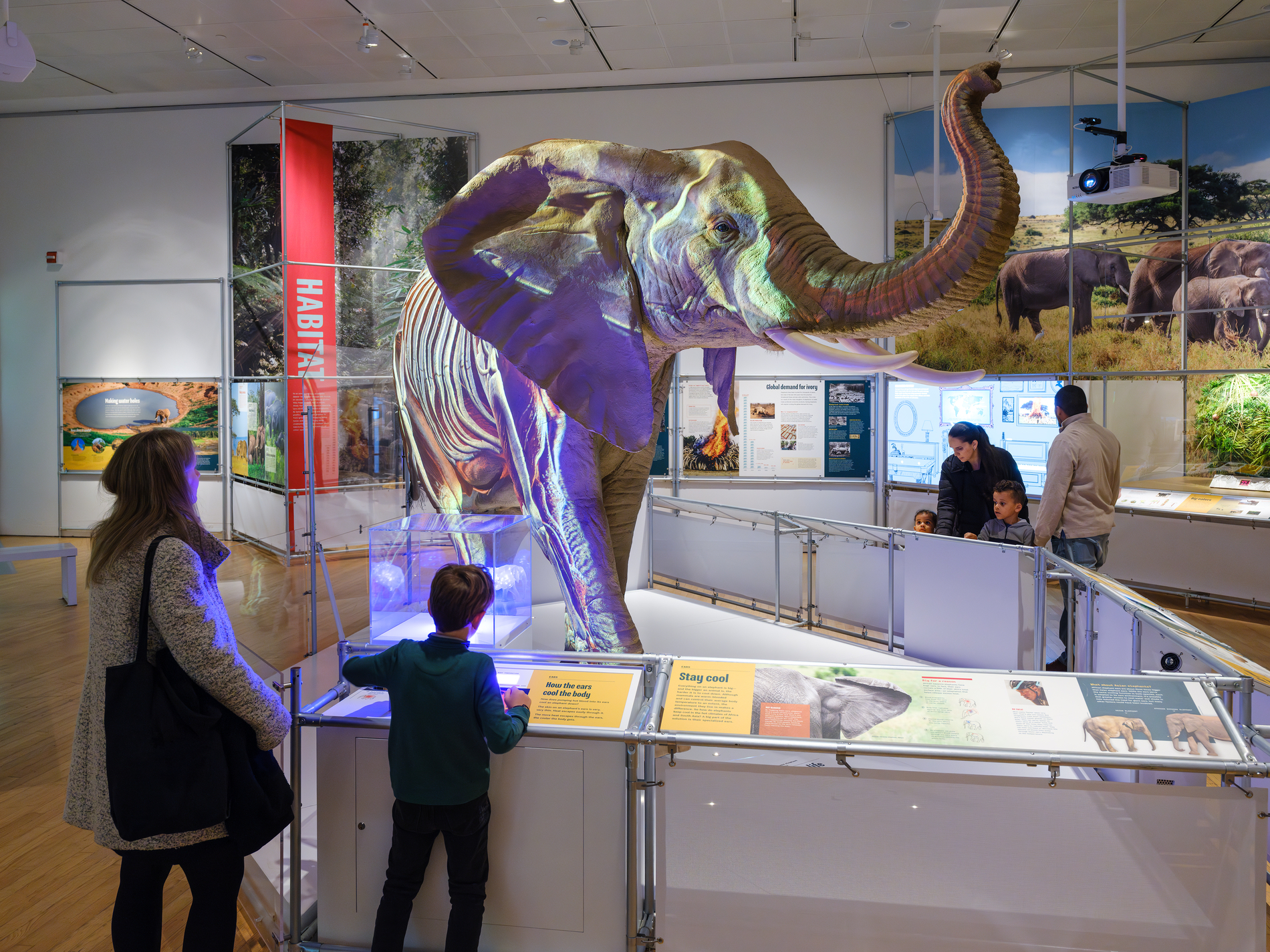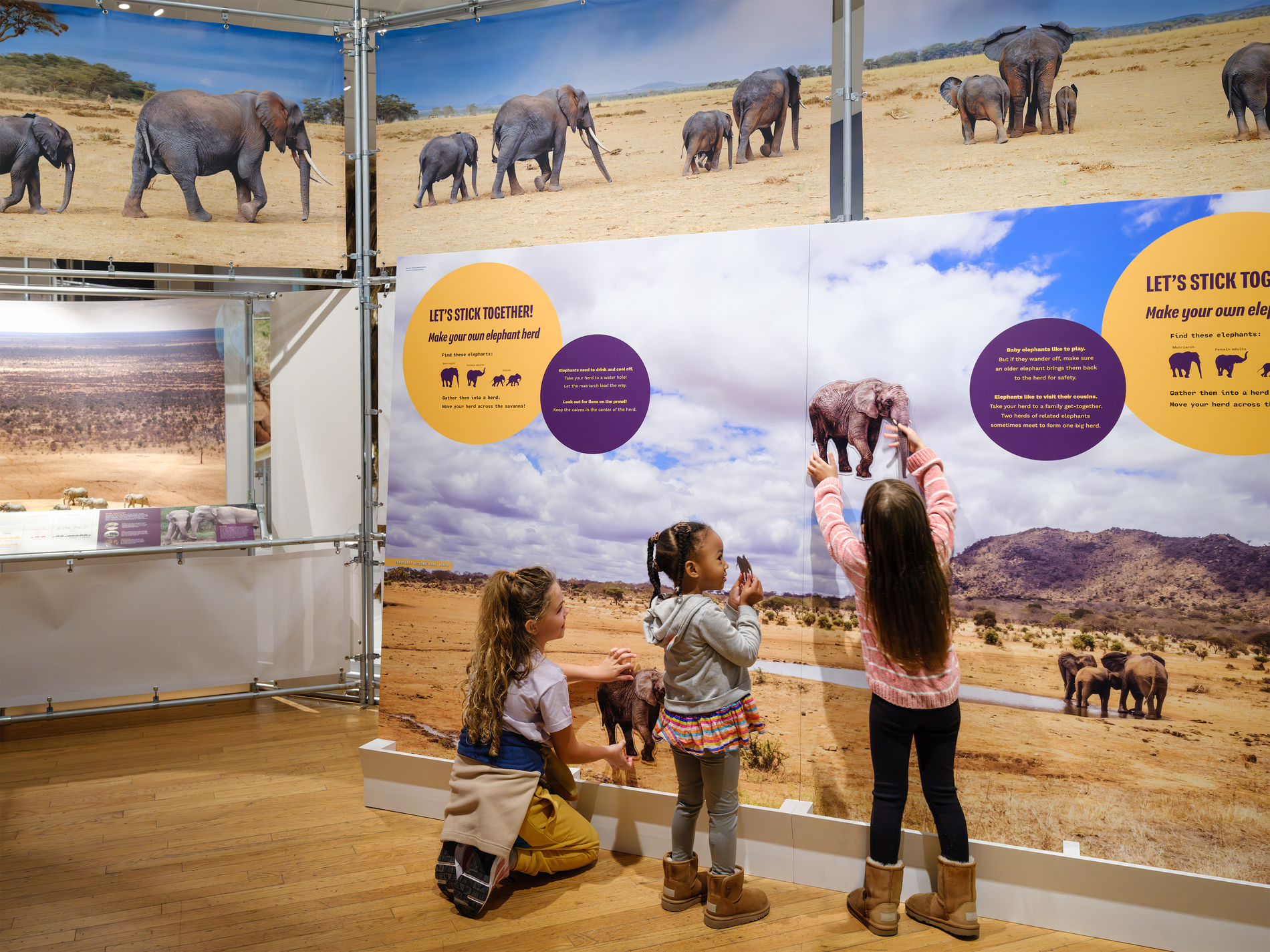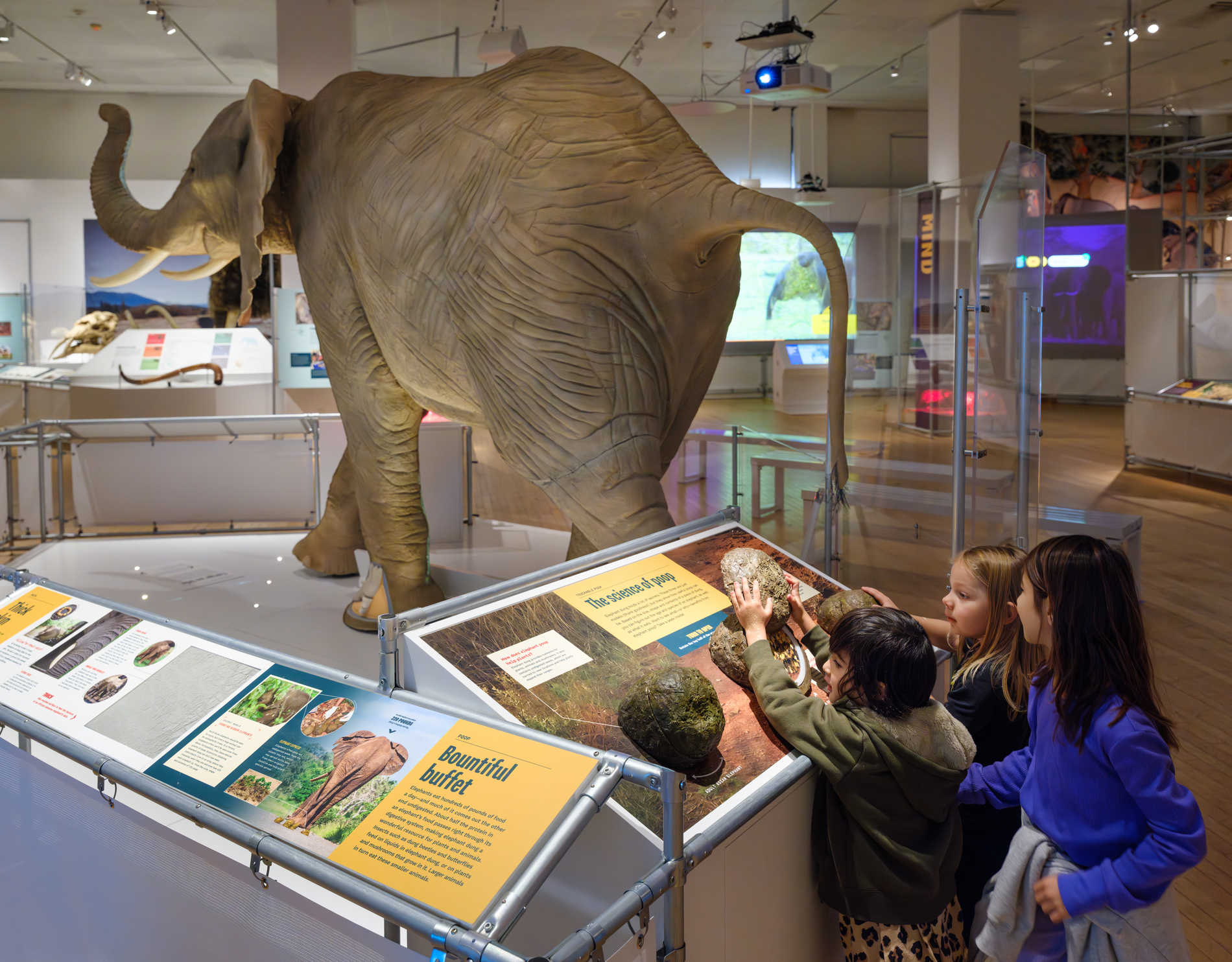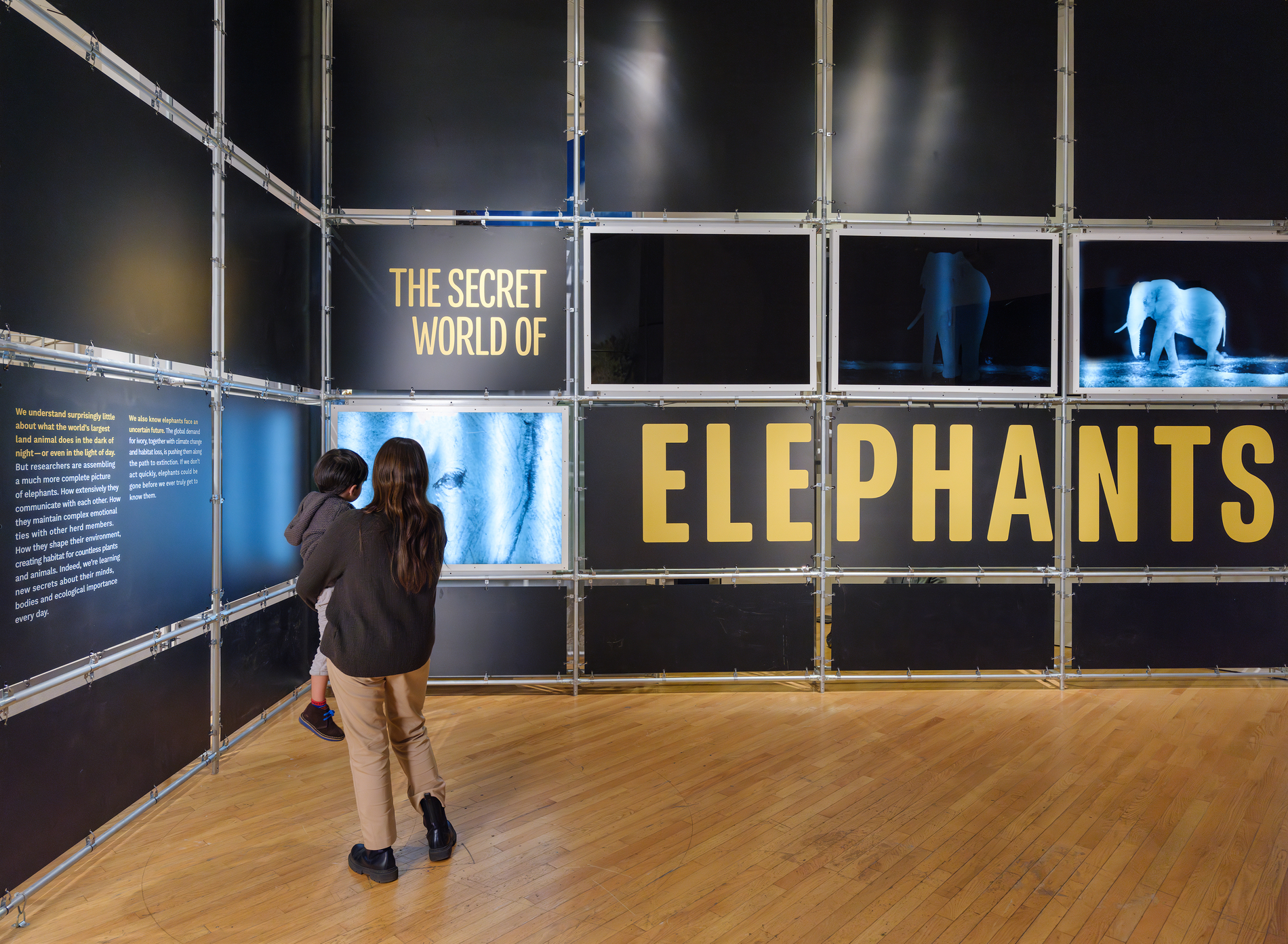CATALYST
DENVER MUSEUM OF NATURE & SCIENCE ONLINE MAGAZINE
Understanding Nature’s Most Loveable Giants
The Museum Team is Excited to Host ‘The Secret World of Elephants’

The exhibition features a life-size model of an African elephant—the largest living land animal. A video projection on one side of the African elephant model shows the skeleton of this massive mammal and provides an inside look at how it processes the huge amount of food it eats—about 300–500 pounds per day—and elephant gestation, which can last for nearly two years, longer than any other living mammal. (Photo/ Alvaro Keding/© AMNH)
Few creatures inspire awe quite like elephants. Towering in size yet gentle in spirit, they are living symbols of strength, memory and kinship. With their sweeping tusks, intelligent eyes and intricate social lives, elephants embody both mystery and beauty. They are also among the most studied - and most endangered - animals in the world.
On Oct. 24, our Museum is proud to unveil “The Secret Lives of Elephants,” an interactive temporary exhibition that celebrates these giants of the animal kingdom. Designed to immerse guests in the natural history, biology and cultural significance of elephants, the exhibition tells the story of their deep evolutionary roots and the challenges they face in today’s changing world. At its heart, lies a message of discovery and conservation through partnerships.

Museum guests can create their own elephant herd with a selection of large magnets representing the matriarch — the leader — as well as other female adults and calves. (Photo/ Alvaro Keding/© AMNH)
Elephants are more than charismatic megafauna; they are ecological engineers. In Africa and Asia, their movements shape landscapes - knocking down trees to create savannahs, dispersing seeds that grow into forests and carving pathways that other species follow. Their impact echoes through ecosystems, reminding us that protecting elephants means protecting countless other plants and animals.
But elephants are also extraordinary in ways that strike closer to the human heart. They live in tight-knit family groups led by matriarchs who carry generations of knowledge. They grieve their dead, recognize themselves in mirrors and communicate through sounds that travel miles underground. Their ability to connect with one another through emotion and memory makes them one of the most relatable non-human species we know.
It is this blend of scientific intrigue and emotional resonance that makes elephants such compelling ambassadors for wildlife conservation.

In "The Secret World of Elephants," visitors can investigate the science of elephant poop through life-size replicas to find out how it provides key nutrients for plants and other animals and helps expand plant ranges by transporting seeds. (Photo/ Alvaro Keding/© AMNH)
The threats elephants face are daunting: poaching for ivory, shrinking habitats and increasing conflict with human communities. But conservation success stories are possible when science, education and compassion come together.
Behind this exciting new exhibition stand teams of researchers, veterinarians and wildlife specialists dedicated to deepening our understanding of animal biology. When natural history museums and zoos work together, we move beyond display and education to drive research that directly supports wildlife health and global conservation efforts. By uniting fieldwork, veterinary expertise and laboratory science, these collaborations yield insights that enhance animal care under human stewardship and inform conservation strategies worldwide.
In partnership with the Denver Zoo Conservation Alliance, biologists at the Museum bring tools of analysis to zoological specimens - examining morphology, sequencing DNA and placing findings in the broader context of evolution and ecology. Together, we are able to ask the big questions:
How do animals resist disease? How do their bodies adapt to extreme diets or climates? What can genetics reveal about the health and survival of wild populations?
For example, studying how wildlife respond to environmental pressures can help predict the impacts of climate change and emerging diseases - knowledge that is vital for protecting vulnerable species and ecosystems.
Together, we foster both understanding and action. Visitors to the exhibition will not only meet elephants through interactive displays and life-sized reconstructions but also learn how they can support ongoing field projects and community-based conservation programs abroad.
Just as elephants rely on family networks, protecting them requires networks of people and institutions united in purpose. Our collaboration is one such network - and one we hope will inspire others.

"The Secret World of Elephants," a temporary exhibition at the Denver Museum of Nature & Science, reveals new science about both modern and ancient elephant relatives and highlights elephants’ extraordinary minds and senses, why they're essential to the health of their ecosystems and inspiring efforts to overcome threats to their survival. (Photo/ Alvaro Keding/© AMNH)
We are living at a critical time for elephant conservation. Populations of African forest elephants have plummeted by more than 80% in the last century, while Asian elephants are now restricted to less than 15% of their historic range. Every decision we make today will shape whether future generations know elephants as thriving wildlife or fading legends.
This new exhibition is more than a window into the life of elephants: it is a call to action. By learning their stories, appreciating their intelligence and beauty, each guest can become part of their future through by supporting of conservation efforts.

Elephants are powerful religious and political symbols across cultures. For example, the Hindu god Ganesh, known as the remover of obstacles, has an elephant’s head and a human-like body. (Photo/ Alvaro Keding/© AMNH)
We invite you to walk among the giants. Listen to the low rumble of elephant calls, trace the curve of ancient tusks, and marvel at the bones of extinct relatives that once roamed North America. Discover the research happening right here, where museum and zoo experts unite their knowledge to keep elephants healthy both in human care and in the wild.
Most importantly, we invite you to be inspired - with a deeper understanding of elephants and a renewed commitment to protect them. Because when elephants thrive, so does the world around them.
Fall 2025
In This Edition
-
The Mystery of the Missing Bison — Solved After 50 Years
This 650-Pound Museum Bison Vanished. Here’s How We Got It Back.
-
A Refresh for Insects and Butterflies
Our Iconic, Toddler-Fan-Favorite Lady Bug on the First Floor has Gotten a ‘Facelift’
-
Understanding Nature’s Most Loveable Giants
The Museum Team is Excited to Host ‘The Secret World of Elephants’
-
6 Marvelous Moths from the Museum’s Entomology Collection
Stunning Moths You Never Knew You Needed to See
-
Connecting Scientists to the Colorado State Legislature
Premiering the Colorado Science & Technology Policy Program & Fellows
Share this:
